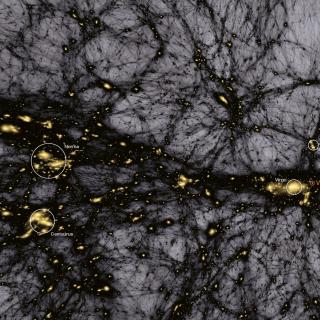Bibcode
López-Corredoira, M.; Melia, F.; Wei, J. -J.; Gao, C. -Y.
Bibliographical reference
The Astrophysical Journal
Advertised on:
7
2024
Journal
Citations
4
Refereed citations
3
Description
Recent James Webb Space Telescope data analyses have shown that massive red galaxies existed at redshifts z ≳ 6, a discovery that is difficult to understand in the context of standard cosmology (ΛCDM). Here, we analyze these observations more deeply, by fitting a stellar population model to the optical and near-infrared photometric data. These fits include a main stellar population in addition to a residual younger population and with the same extinction for both (a lower extinction for the younger population is unphysical). Extra stellar populations or the inclusion of an active galactic nucleus component do not significantly improve the fits. These galaxies are being viewed at very high redshifts, with an average <z> ≈ 8.2, when the ΛCDM Universe was only ≈600 Myr old. This result conflicts with the inferred ages of these galaxies, however, which were on average between 0.9 and 2.4 Gyr old within a 95% confidence level. Given the sequence of star formation and galaxy assembly in the standard model, these galaxies should instead be even younger than 290 Myr on average, for which our analysis assigns a probability of only <3 × 10‑4 (≳3.6σ tension). This outcome may indicate the need to consider nonstandard cosmologies. Nevertheless, our conclusions result from several approximations in stellar astrophysics and extinction, so they should be taken with a grain of salt. Further research is necessary to corroborate the possible existence of galaxies older than the ΛCDM Universe at their observed redshifts.
Related projects

Cosmology with Large Scale Structure Probes
The Cosmic Microwave Background (CMB) contains the statistical information about the early seeds of the structure formation in our Universe. Its natural counterpart in the local universe is the distribution of galaxies that arises as a result of gravitational growth of those primordial and small density fluctuations. The characterization of the
FRANCISCO SHU
KITAURA JOYANES